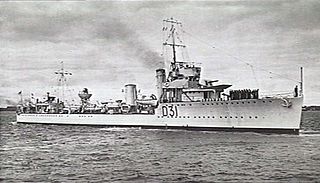Battle honours
Ships named Hobart have earned the following battle honours:
- East Indies, 1940
- Indian Ocean, 1941
- Mediterranean, 1941
- Coral Sea, 1942
- Savo Island, 1942
- Guadalcanal, 1942
- Pacific, 1942−45
- Borneo, 1945
- Vietnam, 1967−70
Three ships of the Royal Australian Navy (RAN) have been named HMAS Hobart, for Hobart, the capital city of Tasmania.
Ships named Hobart have earned the following battle honours:

Five ships of the Royal Australian Navy (RAN) have been named HMAS Sydney, after Sydney, the capital city of New South Wales.
Two ships of the Royal Australian Navy have borne the name HMAS Arunta, a name derived from the Arrernte Aboriginals of central Australia.
Three ships and a naval base of the Royal Australian Navy have been named HMAS Brisbane after Brisbane, the capital city of Queensland.
Four ships of the Royal Australian Navy been named HMAS Parramatta, for the Parramatta River. The name comes from the Barramattagal people.
Three ships of the Royal Australian Navy (RAN) have been named HMAS Perth after Perth, the capital city of Western Australia.
Three ships of the Royal Australian Navy (RAN) have been named HMAS Stuart:
Three ships of the Royal Australian Navy (RAN) have been named HMAS Swan, for the Swan River in Western Australia.
Two ships of the Royal Australian Navy (RAN) have been named HMAS Vampire.
Two ships of the Royal Australian Navy (RAN) have been named HMAS Vendetta.
Two ships of the Royal Australian Navy (RAN) have been named HMAS Voyager.
Two ships of the Royal Australian Navy have been named HMAS Warrego, for the Warrego River in Queensland.
There have been one ship and one shore establishment in the Royal Australian Navy (RAN) named HMAS Waterhen. The first ship originally served under the name HMS Waterhen with the Royal Navy (RN). A British ship and an Australian ship of the name were ordered but later cancelled.
Four ships of the Royal Australian Navy (RAN) have been named HMAS Yarra after the Yarra River in Victoria.

The Leander class was a class of eight light cruisers built for the Royal Navy in the early 1930s that saw service in World War II. They were named after mythological figures, and all ships were commissioned between 1933 and 1936. The three ships of the second group were sold to the Royal Australian Navy (RAN) before World War II and renamed after Australian cities.

HMAS Stuart was a British Scott-class flotilla leader. The ship was built by Hawthorn Leslie and Company for the Royal Navy during World War I, and entered service at the end of 1918. The majority of the destroyer's British service was performed in the Mediterranean, and in 1933 she was transferred to the Royal Australian Navy. Although placed in reserve in 1938, Stuart was reactivated at the start of World War II to lead the Australian destroyer force, nicknamed the "Scrap Iron Flotilla" by German propagandists.

HMAS Hobart was a modified Leander-class light cruiser which served in the Royal Australian Navy (RAN) during World War II. Originally constructed for the Royal Navy as HMS Apollo, the ship entered service in 1936, and was sold to Australia two years later. During the war, Hobart was involved in the evacuation of British Somaliland in 1940, fought at the Battle of the Coral Sea and supported the amphibious landings at Guadalcanal and Tulagi in 1942. She was torpedoed by a Japanese submarine in 1943, then returned to service in 1945 and supported the landings at Tarakan, Wewak, Brunei, and Balikpapan. Hobart was placed in reserve in 1947, but plans to modernise her and return her to service as an aircraft carrier escort, training ship, or guided missile ship were not followed through. The cruiser was sold for scrapping in 1962.

HMAS Voyager (D31/I31) was a W-class destroyer of the Royal Navy (RN) and Royal Australian Navy (RAN). Commissioned into the RN in 1918, the destroyer remained in RN service until 1933, when she was transferred to the RAN. Recommissioned, Voyager served in the Mediterranean and Pacific theatres of World War II until 23 September 1942, when she ran aground while trying to deliver troops to Timor. The ship was damaged by Japanese bombers while trying to refloat, then was scuttled by her crew.

HMAS Kuttabul is a Royal Australian Navy (RAN) base located in Potts Point in Sydney, New South Wales, Australia. Kuttabul provides administrative, training, logistics and accommodation support to naval personnel assigned to the various facilities that form Fleet Base East, the main operational navy base on the east coast of Australia. A part of Fleet Base East itself, Kuttabul occupies several buildings in the Sydney suburb of Potts Point and in the immediately adjacent Garden Island dockyard. It also supports navy personnel posted to other locations throughout the greater Sydney region.

The history of the Royal Australian Navy traces the development of the Royal Australian Navy (RAN) from the colonisation of Australia by the British in 1788. Until 1859, vessels of the Royal Navy made frequent trips to the new colonies. In 1859, the Australia Squadron was formed as a separate squadron and remained in Australia until 1913. Until Federation, five of the six Australian colonies operated their own colonial naval force, which formed on 1 March 1901 the Australian Navy's (AN) Commonwealth Naval Force which received Royal patronage in July 1911 and was from that time referred to as Royal Australian Navy (RAN). On 4 October 1913 the new replacement fleet for the foundation fleet of 1901 steamed through Sydney Heads for the first time.
Three ships and a shore establishment of the Royal Navy have borne the name HMS Attack: